Sound of Whales
projectceti.org
"It was perfectly clear to me that nature was under the most appalling assaults, and most people didn’t seem to know anything about it. And I thought, what could I do, if the only thing I know about is the sounds that animals make and respond to? And I thought — whales! That’s what I could do."
Roger Payne
In the late 1960s, scientists, including principal CETI advisor Dr. Roger PAYNE, discovered that whales sing to one another. His recordings, “Songs of the Humpback Whale”, sparked the “Save the Whales” movement, one of the most successful conservation initiatives in history. The campaign eventually led to the Marine Mammal Protection Act that marked the end of large-scale whaling and saved several whale populations from extinction.
All this by just hearing the sounds of whales. Imagine what would happen if we could understand them?
In 2020, Project CETI formed as a 501c3 nonprofit organization with catalyst funding from the TED Audacious Prize.

CETI is a nonprofit organization applying advanced machine learning and state-of-the-art robotics to listen to and translate the communication of sperm whales. Our research focus is in Dominica in the Eastern Caribbean.
ref. # 065 sound of whales -Conscious Breath Adventures
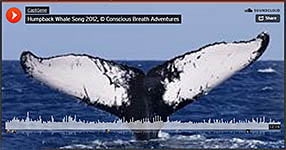 A short recording of a chorus of singing humpback whales on the Silver Bank, Dominican Republic. There were so many whale songs overlapping that it was impossible to make a good estimated count.
A short recording of a chorus of singing humpback whales on the Silver Bank, Dominican Republic. There were so many whale songs overlapping that it was impossible to make a good estimated count.
tags: #whale #sound
ref. # 065a sound of whales -Roger Payne
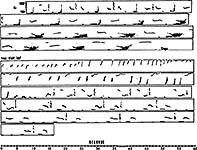 In 1971, the journal Science published a surprising description of singing whales for the first time in the article Songs of Humpback Whales by Roger Payne and Scott McVay. These two biologists found that Humpback whales produce a series of beautiful and varied sounds for a period of 7 to 30 minutes and then repeat the same series with considerable precision. They called this performance 'singing', referring to each repeated series of sounds as a 'song'.
In 1971, the journal Science published a surprising description of singing whales for the first time in the article Songs of Humpback Whales by Roger Payne and Scott McVay. These two biologists found that Humpback whales produce a series of beautiful and varied sounds for a period of 7 to 30 minutes and then repeat the same series with considerable precision. They called this performance 'singing', referring to each repeated series of sounds as a 'song'.SOURCE: www.researchgate.net
©: zeppelinruc.wordpress.com
tags: #Whale #Roger #Payne
ref. # 065b sound of whales -animal sounds made visible by Bell
 the art of memory: drawing sounds exploding bells ...
animal sounds, made visible by bell's translator
http://theartofmemory.blogspot.com/2010/06/drawing-sounds-exploding-bells.html
©:
the art of memory: drawing sounds exploding bells ...
animal sounds, made visible by bell's translator
http://theartofmemory.blogspot.com/2010/06/drawing-sounds-exploding-bells.html
©:tags: #sound #whales #Bell
ref. # 065c sound of whales -Penguins Listening to the Gramophone During Shackleton's 1907-09 Antarctic Expedition
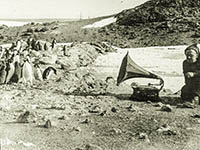 Penguins listening to the gramophone during Shackleton's 1907-09 Antarctic expedition, from 'The Heart of the Antarctic' by Shackleton (1874-1922) published in 1909
Penguins listening to the gramophone during Shackleton's 1907-09 Antarctic expedition, from 'The Heart of the Antarctic' by Shackleton (1874-1922) published in 1909source: www.irishtimes.com
Description: Photographs of the Nimrod Expedition (1907-09) to the Antarctic, led by Ernest Shackleton
Date: 1908
Source: Archive of Alfred Wegener Institute for Polar and Marine Research
Author: Ernest Henry Shackleton (1874-1922)
©: From Paris magazine L'Illustration, October 1909
tags: #Shackleton #Antarctic #penguins
ref. # 065d sound of whales -the Oldest Song in the World
 For fifteen years Prof. Anne Draffkorn Kilmer puzzled over clay tablets relating to music including some excavated in Syria by French archaeologists in the early '50s. The tablets from the Syrian city of ancient Ugarit (modern Ras Shamra) were about 3400 years old, had markings called cuneiform signs in the hurrian language (with borrowed akkadian terms) that provided a form of musical notation. One of the texts formed a complete cult hymn and is the oldest preserved song with notation in the world. Finally in 1972, Kilmer, who is professor of Assyriology, University of California, and a curator at the Lowie Museum of Anthropology at Berkeley, developed an interpretation of the song based on her study of the notation.
For fifteen years Prof. Anne Draffkorn Kilmer puzzled over clay tablets relating to music including some excavated in Syria by French archaeologists in the early '50s. The tablets from the Syrian city of ancient Ugarit (modern Ras Shamra) were about 3400 years old, had markings called cuneiform signs in the hurrian language (with borrowed akkadian terms) that provided a form of musical notation. One of the texts formed a complete cult hymn and is the oldest preserved song with notation in the world. Finally in 1972, Kilmer, who is professor of Assyriology, University of California, and a curator at the Lowie Museum of Anthropology at Berkeley, developed an interpretation of the song based on her study of the notation.© www.youtube.com tags: Anne Draffkorn #Kilmer #Ugarit #clay tablet #sound #song #music
ref. # 065e sound of whales -Darwin's original diagram of evolution
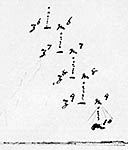 detail from the original diagram of evolution
detail from the original diagram of evolutionorigin of the species
charles darwin - ca. 1857
©: via: theartofmemory.blogspot.com
tags: #darwin
ref. # 065f sound of whales -Whale crier of Hermanus (South Africa)
 Whale crier of Hermanus (South Africa)
©:
Whale crier of Hermanus (South Africa)
©:tags: #whale #crier #Hermanus
065g sound of whales -Science Magazine on Roger Payne
 Science Vol 173, Issue 3997 13 August 1971
Science Vol 173, Issue 3997 13 August 1971SOURCES:
- SCIENCE magazine: "Songs of Humpback Whales" science.sciencemag.org
- "Musician and writer David Rothenberg is currently compiling the best whale songs ever recorded, a collection of which is to be released later this year by Important Records. Here he looks at the human history of whale song and asks "is their musical culture going downhill? Or is it on the rise? Can we humans even tell the difference?" http://www.thewire.co.uk
- Whale vocalisation: wikipedia.org
©: science.sciencemag.org
tags: #Roger #Payne #whale #song #David Rothenberg
ref. # 065h sound of whales -Z.I.R.A.
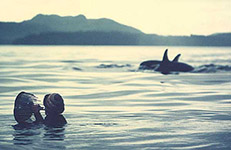 Jim Nollman playing waterphone off western Canada with orcas (1979)
Jim Nollman playing waterphone off western Canada with orcas (1979)SOURCE: Zepelim: the inner reaches of Outsider Radio
©: zeppelinruc.wordpress.com
tags: #communication #music #waterphone #orca #nollman
066 sound of whales -Sound of Whales
 photograph from the exhibition
photograph from the exhibition©: Robert Schilder 2015
tags: #whale #sound
A short recording of a chorus of singing humpback whales on the Silver Bank, Dominican Republic. There were so many whale songs overlapping that it was impossible to make a good estimated count. Learn more about the humpback whales of the Silver Bank at www.ConsciousBreathAdventures.com http://soundcloud.com/captgene/silver-bank-humpback-whale
http://soundcloud.com/captgene/humpback-whale-song-2012-c email: Info@ConsciousBreathAdventures.com
Why a whale's world is a world of sound
Decoding whale vocalizations is helping scientists understand the culture differences among the species.
Published April 15, 2021
In 1970, a groundbreaking album introduced the "songs" of humpback whales to the world. It piqued public curiosity about the social lives of these ocean giants and spurred a global movement to research and conserve their populations. Several decades later, scientists continue to study the intricate vocalizations of not just humpbacks but the nearly 90 cetacean species inhabiting the world's oceans. They're decoding the wide array of sounds that the species use to communicate and finding cultural differences between populations.
Hear from National Geographic Explorers Natalie Sinclair, a humpback whale researcher, and sperm whale expert Shane Gero as they discuss how studying these two species' unique vocalizations are changing the way we understand whales.
www.nationalgeographic.com/animals/article/why-a-whales-world-is-a-world-of-sound
January 29, 2015
Fin Whale Sound Reception Mechanisms: Skull Vibration Enables Low-Frequency Hearing
.. "We CT scanned the head of a small fin whale (Balaenoptera physalus) in a scanner designed for solid-fuel rocket motors. Our computer (finite element) modeling toolkit allowed us to visualize what occurs when sounds interact with the anatomic geometry of the whale’s head. Simulations reveal two mechanisms that excite both bony ear complexes, the skull-vibration enabled bone conduction mechanism and a pressure mechanism transmitted through soft tissues." ..
Citation: Cranford TW, Krysl P (2015) Fin Whale Sound Reception Mechanisms: Skull Vibration Enables Low-Frequency Hearing. PLoS ONE 10(1): e0116222. https://doi.org/10.1371/journal.pone.0116222
Vinvis hoort met behulp van botstructuur
